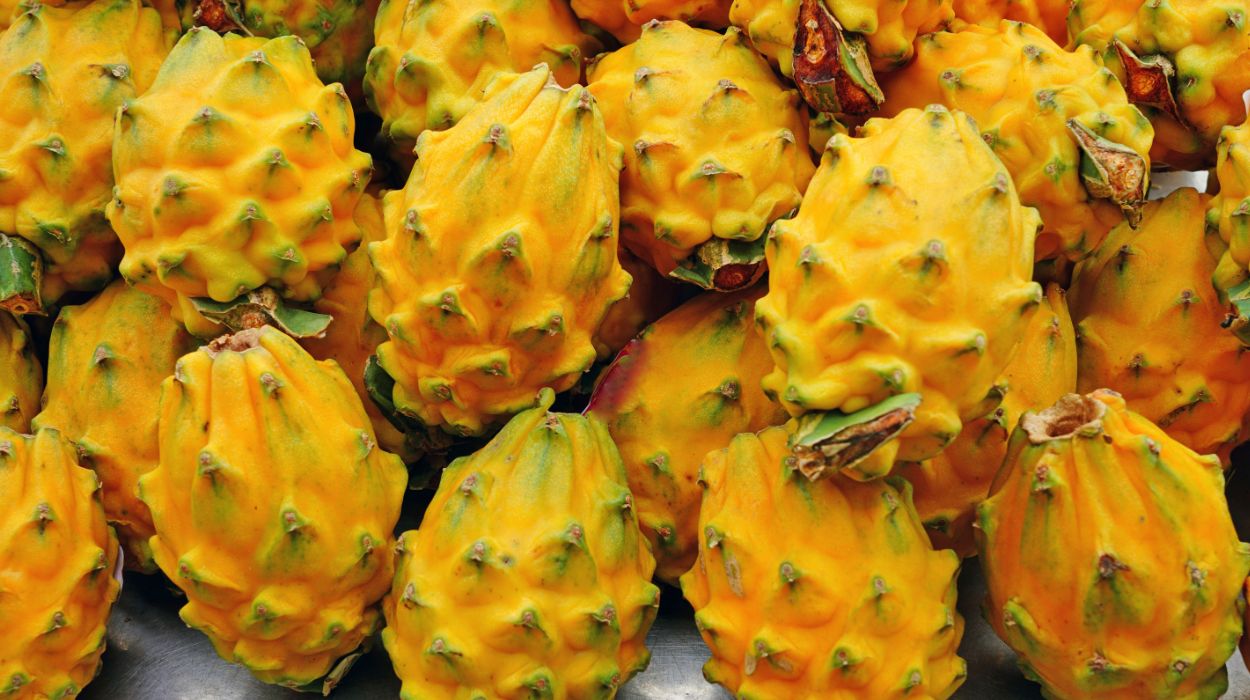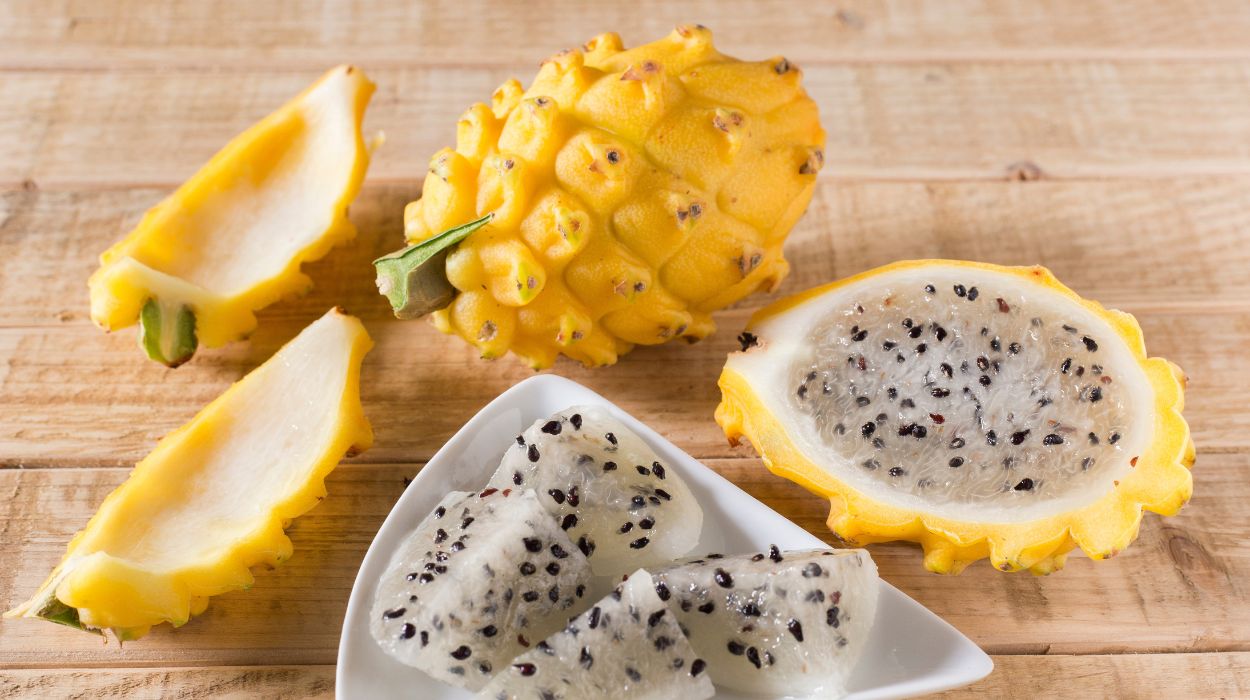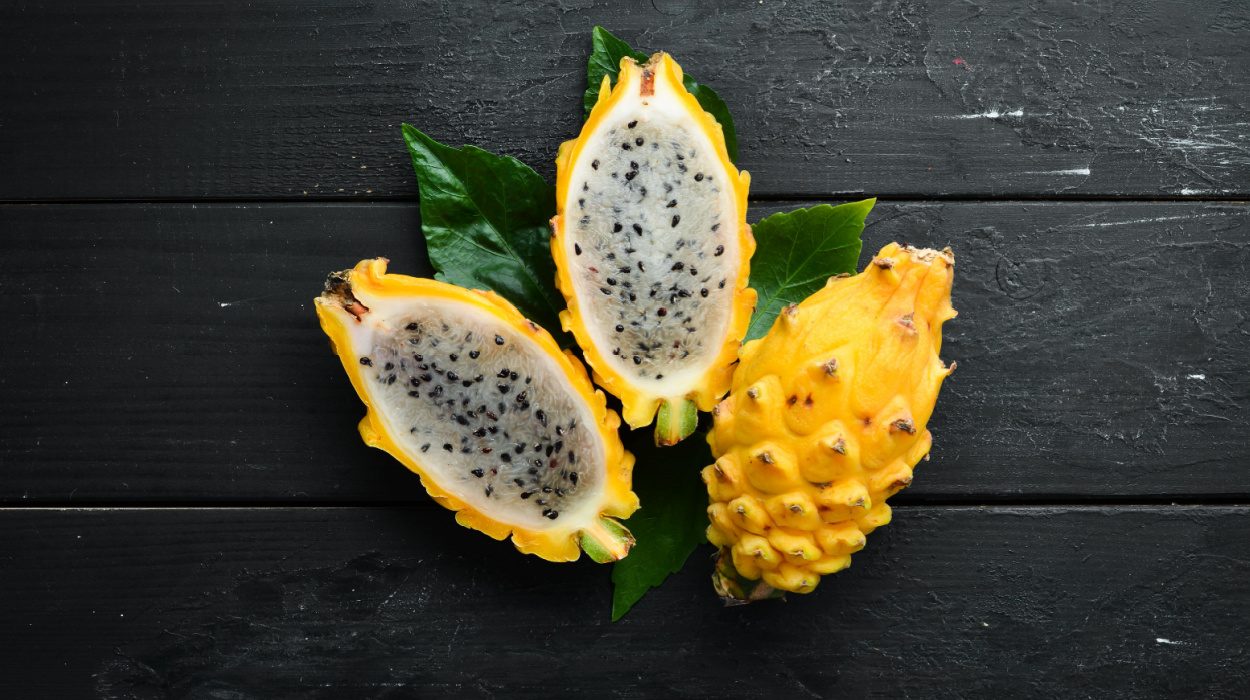Yellow dragon fruit, a tropical gem from the cactus family, shines for its gorgeous golden hue and its extensive health benefits.
Originating from tropical lands such as Costa Rica, where it’s known as Pitaya, this exotic fruit is full of vitamins, nutrients, and antioxidants.
Are you curious to find out about yellow dragon fruit benefits? Read on to find out more about its nutritional value and how it can be a good addition to other fruits for weight loss. Let’s dive into the details about what to expect from eating this fruit.
Health Benefits Of Yellow Dragon Fruit
Yellow dragon fruit health benefits:
- Antioxidant properties.
- Healthy Skin.
- Digestive Health.
- Heart Health.
- Blood Sugar Regulation.
- Hydration and Weight Management.
- Nutrient Rich.
Health Benefits Of Yellow Dragon Fruit

Antioxidant Properties
Did you know that dragon fruit is a superfood? It is known for its antioxidant benefits[1] because, within its peel and pulp, it contains:
- Polyphenols: Which have anti-inflammatory properties[2] and aid in decreasing oxidative stress.
- Flavonoids: These may help reduce free radicals[3] in your body improving overall health.
- Vitamin C: Helps to boost your immune system[4] and is essential for tissue growth, development, and repair.
Healthy Skin
Due to the antioxidant properties of yellow dragon fruit, it can be highly beneficial in skin health and anti-aging.[5] Having anti-inflammatory benefits and protecting against free radical damage because of high levels of vitamin C,[6] this tropical fruit can aid in keeping your skin healthy by neutralizing the negative effects.
Natural skin products using dragon fruit may also be very beneficial – keeping your skin looking bright and bouncy and protecting you from premature aging.
Digestive Health
This tropical fruit is high in dietary fiber – which is known to have an important role in keeping your gut healthy and helping prevent inflammatory conditions[7] such as bowel disease, obesity, and diabetes. It also has prebiotic effects[8] which aid in digestion.
Consuming adequate levels of fiber, keeps your gut microbiome balanced with beneficial bacteria. It is recommended to eat 23-38 grams of fiber a day to ensure optimum health – one cup of yellow dragon fruit contains 5.58 grams of dietary fiber, setting you on the right path to achieving sufficient daily intake.
Heart Health
Consuming yellow dragon fruit may support cardiovascular health due to its fiber content and nutrient profile. Because of their anti-inflammatory properties, consuming them and having an overall higher intake of fruit and vegetables[9] can also lower your risk of chronic diseases[10] such as heart disease,[11] diabetes,[12] and cancer.[13]
Blood Sugar Regulation
While the sugars in this unique fruit are natural, they are present in moderate amounts. White pitaya juice has been shown to improve insulin resistance,[14] and a high amount of soluble fiber can help in managing blood sugar levels.[15]
Hydration And Weight Management
The health benefits of yellow dragon fruit include weight management.[16] They provide a natural sweetness with a low-calorie content compared to other desserts and snacks. The fiber in this healthy fruit helps to keep you full for longer, which can control your appetite and reduce your caloric intake.
You can eat dragon fruit to aid in your overall daily hydration as they have a high water content. Being hydrated is essential to overall health and proper functioning. According to the EFSA guidelines,[17] you should aim to drink 6-8 cups of water per day.
Nutrients
Yellow dragon fruit is nutrient-dense and worth adding to a healthy diet. As well as vitamin C, it also contains vitamin B2 – riboflavin,[18] and B3 – niacin,[19] both supporting a healthy metabolism and nervous system. The antioxidant properties promote healthy skin.
And there’s more, yellow dragon fruit is also a source of iron. Eating foods with iron helps prevent iron deficiency and the risk of anemia[20] which many women may be vulnerable to. The iron molecule is essential[21] for the transport of oxygen in the blood.
What Is A Yellow Dragon Fruit?

Yellow dragon fruit, sometimes referred to as a strawberry pear, is a tropical fruit native to Central America – Southern Mexico, Guatemala, and Costa Rica. It is also known as the Pitaya or Pitahaya[22] and is grown commercially across other parts of South America and Asia.
Now, let’s look at some dragon fruit varieties that you may have seen around:
- Pink skin and white flesh.
- Pink skin and red flesh.
- Pink skin and violet-red flesh.
- Reddish-orange skin and red flesh.
- Yellow skin and white flesh.
They all have green scales, which give dragon fruits their name. All variations of these tropical fruits contain edible black seeds, have a slightly sweet taste, and are rich in nutrients, vitamins, and minerals. Make sure to choose ripe fruit from your local store, and check for bright-colored skin and some softness when squeezed.
You can eat yellow dragon fruit by eating it fresh as it is, slicing it in fruit salad, or adding it to a smoothie. Mix it with some yogurt along with chopped nuts for a healthy snack or add them to desserts. Eating more fruit and vegetables and maintaining a balanced diet is a great way to beat any sugar cravings.
Nutritional Value Of Yellow Dragon Fruit
According to the USDA,[23] one cup of dragon fruit contains 103 calories. It also contains many essential vitamins and nutrients listed below:
- Calcium: 16.2 mg.
- Fiber: 5.58 g.
- Magnesium: 12.6 mg.
- Phosphorus: 21.6 mg.
- Potassium: 209 mg.
- Vitamin C: 7.74 mg.
- Carotene, beta: 25.2 mg.
- Vitamin A: 1.8 mg.
- Folate: 12.6 mg.
- Water: 84 g.
- Iron: 0.324 mg.
- Niacin: 0.161 mg.
- Riboflavin: 0.026 mg.
Is Yellow Dragon Fruit Good For You?
Is yellow dragon fruit good for you? Yes, dragon fruit benefits are ample. Because of its high nutrient content and being naturally low in calories, it is known to boost immunity and improve health. Considering all the nutrients and minerals in yellow dragon fruit, adding it to your diet may be very beneficial.
Does dragon fruit make you poop? Because of its dietary fiber and water content, which aid in good digestion and promote beneficial bacteria,[24] it can act as a natural laxative. So, eating yellow dragon fruit can contribute to regular bowel movements.
Be sure to eat a balanced diet and include a variety of vegetables and even other tropical fruits that catch your eye in the grocery stores. If you are looking for an extra addition to your smoothies or salads, consider some of the best green powders that you could add to boost your nutrient intake. Always try to get as much of your daily nutrient intake from foods before adding extra fruit and vegetable supplements to your diet.
Yellow Dragon Fruit Side Effects
On the whole, yellow dragon fruit has many benefits and it’s safe to eat – however, it also has some side effects. Some people may experience adverse side effects such as allergic reactions. So, if you notice any itching or hives or even swelling and difficulty breathing after eating dragon fruit, be sure to reach out to a doctor immediately.
Yellow dragon fruit has many benefits and also some side effects to be aware of. Due to the high fiber content, eating more than two a day could cause bloating and gas. Be sure to eat it in moderation and incorporate fiber into your diet gradually. Yellow dragon fruit has many benefits and also some side effects to be aware of.
The natural laxative effect that dragon fruit can have, may be beneficial for constipation and encouraging healthy bowel movements, however, in others, it may cause diarrhea, so be mindful of your portions and avoid eating them in excess. One serving a couple of times a week is about right.
Dragon fruit contains oxalates, which are found in many fruits and vegetables. A high amount of oxalates[25] can form kidney stones. So if you are prone to kidney stones may want to consider this and speak to your health provider if there are any concerns about your diet.
Conclusion
To sum up, yellow dragon fruit is a tropical marvel from the cactus family and has extensive health benefits. This exotic fruit from Central America is rich in vitamins, nutrients, and antioxidants. The benefits range from antioxidant properties, promoting healthy skin and supporting your digestive health to contributing to a healthy heart and helping with blood sugar regulation.
Also, its low-calorie content and natural laxative properties make it a valuable fruit to add to a balanced diet. You can enjoy them in many ways – adding them to smoothies along with green powder, or in desserts. It’s essential to be mindful of any side effects such as allergic reactions and digestive discomfort, and to eat it in moderation.
Frequently Asked Questions
Yellow dragon fruit has many potential health benefits – it aids in maintaining a healthy gut and digestive tract. And it has some key nutrients and antioxidants that help reduce free radical damage and support a healthy immune system.
Yes. Due to its high fiber and water content, it can act as a natural laxative for those suffering from constipation.
All dragon fruits contain essential nutrients, minerals, and antioxidants and are all healthy additions to the dragon fruit plant.
Dragon fruit nutrition is similar in all varieties, the bright red skin of some kinds contains antioxidant pigments and is sweeter than the yellow kind which has a milder flavor.
Stick to one serving of yellow dragon fruit a couple of times a week to get all the benefits and avoid any potential side effects of overeating this fruit.
No, yellow dragon fruit is slightly less sweet than red dragon fruit.
As it contains many antioxidants and vitamins it could certainly contribute to a detox plan.
Yellow dragon fruit can contribute to good blood sugar levels which may be beneficial for diabetes.
 Evidence Based
Evidence Based
